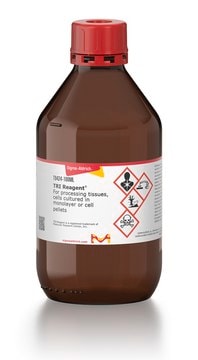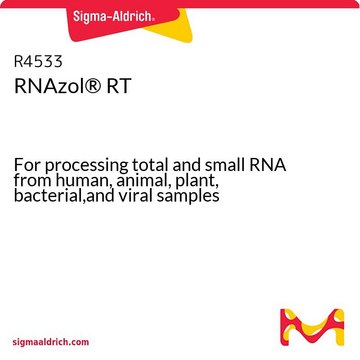B9673
1-Bromo-3-chloropropane
for isolation of RNA
Synonym(s):
1-Bromo-3-chloropropane, I-BCP, Trimethylene bromochloride, Trimethylene chlorobromide
About This Item
for molecular biology
Recommended Products
grade
Molecular Biology
for molecular biology
assay
≥98.5% (GC)
form
liquid
refractive index
n20/D 1.486 (lit.)
bp
144-145 °C (lit.)
density
1.592 g/mL at 25 °C (lit.)
storage temp.
room temp
SMILES string
ClCCCBr
InChI
1S/C3H6BrCl/c4-2-1-3-5/h1-3H2
InChI key
MFESCIUQSIBMSM-UHFFFAOYSA-N
Looking for similar products? Visit Product Comparison Guide
General description
Application
- feline teeth
- mice brain and liver tissues
- human ectocervical epithelial cells
- placental samples
- human mesenchymal stromal cells (hMSCs)
Features and Benefits
- less toxic alternative to chloroform
- compatible with TRI reagent for isolation of RNA with decreased DNA contamination
Other Notes
Related product
signalword
Danger
hcodes
Hazard Classifications
Acute Tox. 3 Inhalation - Acute Tox. 4 Oral - Aquatic Chronic 3 - Muta. 2 - STOT SE 3
target_organs
Respiratory system
Storage Class
6.1C - Combustible acute toxic Cat.3 / toxic compounds or compounds which causing chronic effects
wgk_germany
WGK 2
ppe
Eyeshields, Faceshields, Gloves, type ABEK (EN14387) respirator filter
Choose from one of the most recent versions:
Already Own This Product?
Find documentation for the products that you have recently purchased in the Document Library.
Customers Also Viewed
Protocols
TRI Reagent is a single-step RNA isolation reagent that allows simultaneous isolation of DNA, RNA and protein. This protocol outlines sample prep as well as extraction of the various samples and troubleshooting.
Our team of scientists has experience in all areas of research including Life Science, Material Science, Chemical Synthesis, Chromatography, Analytical and many others.
Contact Technical Service












